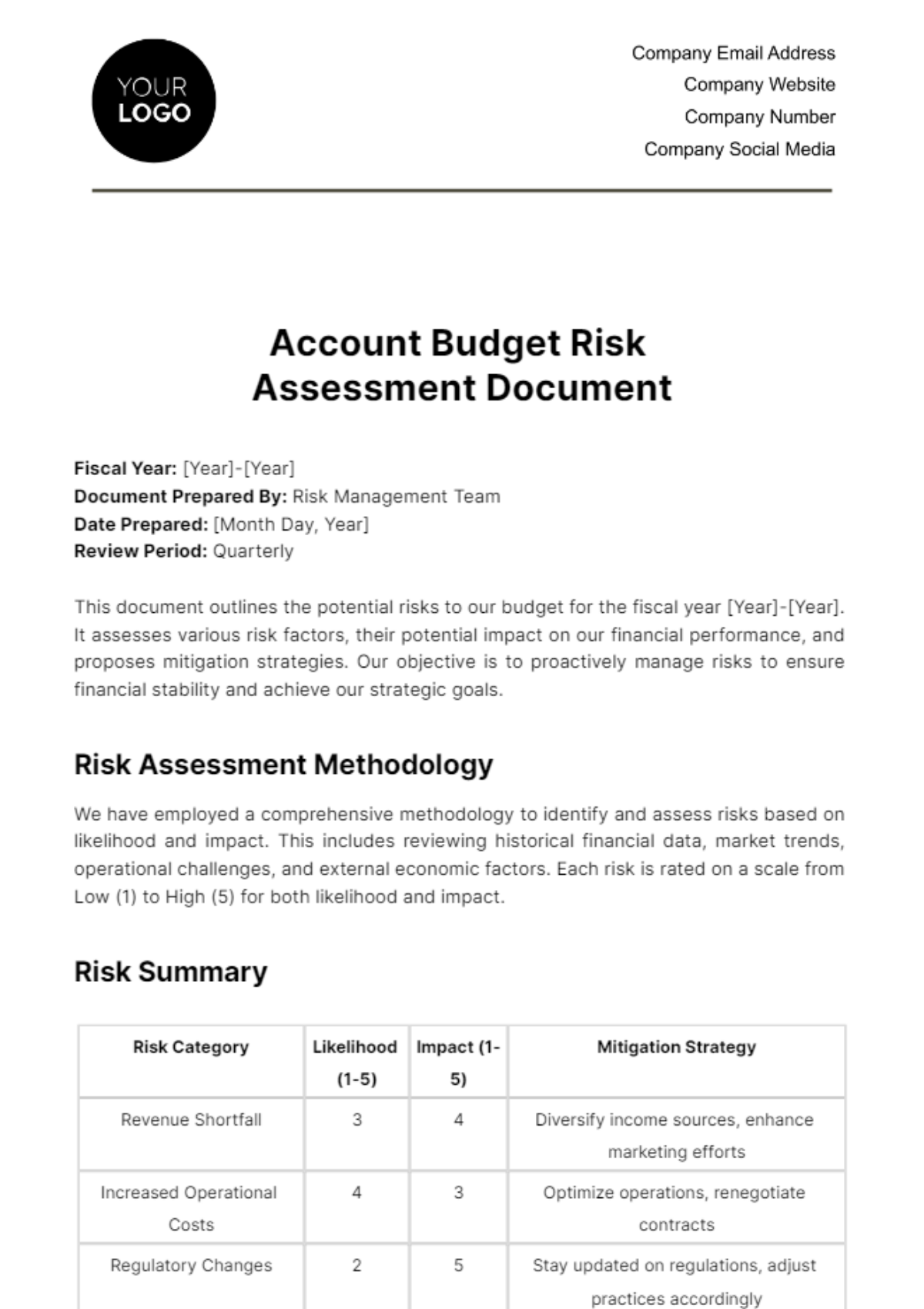Account Budget Risk
Assessment Document
Fiscal Year: [Year]-[Year]
Document Prepared By: Risk Management Team
Date Prepared: [Month Day, Year]
Review Period: Quarterly
This document outlines the potential risks to our budget for the fiscal year [Year]-[Year]. It assesses various risk factors, their potential impact on our financial performance, and proposes mitigation strategies. Our objective is to proactively manage risks to ensure financial stability and achieve our strategic goals.
Risk Assessment Methodology
We have employed a comprehensive methodology to identify and assess risks based on likelihood and impact. This includes reviewing historical financial data, market trends, operational challenges, and external economic factors. Each risk is rated on a scale from Low (1) to High (5) for both likelihood and impact.
Risk Summary
Risk Category | Likelihood (1-5) | Impact (1-5) | Mitigation Strategy |
Revenue Shortfall | 3 | 4 | Diversify income sources, enhance marketing efforts |
Increased Operational Costs | 4 | 3 | Optimize operations, renegotiate contracts |
Regulatory Changes | 2 | 5 | Stay updated on regulations, adjust practices accordingly |
Supply Chain Disruption | 3 | 4 | Develop alternate supplier relationships |
Technological Failures | 2 | 4 | Invest in robust IT infrastructure, regular maintenance |
Detailed Risk Analysis
Revenue Shortfall
Potential Causes: Economic downturn, loss of key clients, increased competition.
Impact Analysis: A significant shortfall could affect our ability to fund strategic initiatives and meet operational costs.
Mitigation: Diversify product offerings and markets, strengthen customer relationships, increase marketing and sales efforts.
Increased Operational Costs
Potential Causes: Inflation, higher raw material costs, wage increases.
Impact Analysis: Rising costs could erode profit margins and reduce net income.
Mitigation: Streamline operations for efficiency, renegotiate supplier contracts, and implement cost-control measures.
Regulatory Changes
Potential Causes: New laws or regulations affecting our industry.
Impact Analysis: Compliance costs may rise, impacting profitability. Non-compliance could lead to fines or legal issues.
Mitigation: Regularly monitor regulatory changes, ensure compliance, and engage in lobbying where necessary.
Supply Chain Disruption
Potential Causes: Natural disasters, geopolitical events, supplier bankruptcy.
Impact Analysis: Disruptions can lead to production delays, increased costs, and inability to meet customer demand.
Mitigation: Establish relationships with multiple suppliers, maintain adequate inventory levels, develop contingency plans.
Technological Failures
Potential Causes: Cyber-attacks, system outages, obsolete technology.
Impact Analysis: Can lead to operational disruptions, data breaches, and significant recovery costs.
Mitigation: Invest in cybersecurity, regular system upgrades, and disaster recovery planning.
Conclusion
Our proactive approach to risk management enables us to identify potential threats to our budget and financial stability early on. By implementing the outlined mitigation strategies, we aim to minimize the impact of these risks and ensure the organization remains on a solid financial footing.
Next Steps
Each department will be responsible for implementing the relevant mitigation strategies. The Risk Management Team will conduct quarterly reviews to assess the effectiveness of the mitigation strategies and adjust as necessary.
Prepared by: [Name], [Position]
Date:
Reviewed by: [Name], [Position]
Date:
Approved by: [Name], [Position]
Date:
Accounting Templates @ Template.net






























